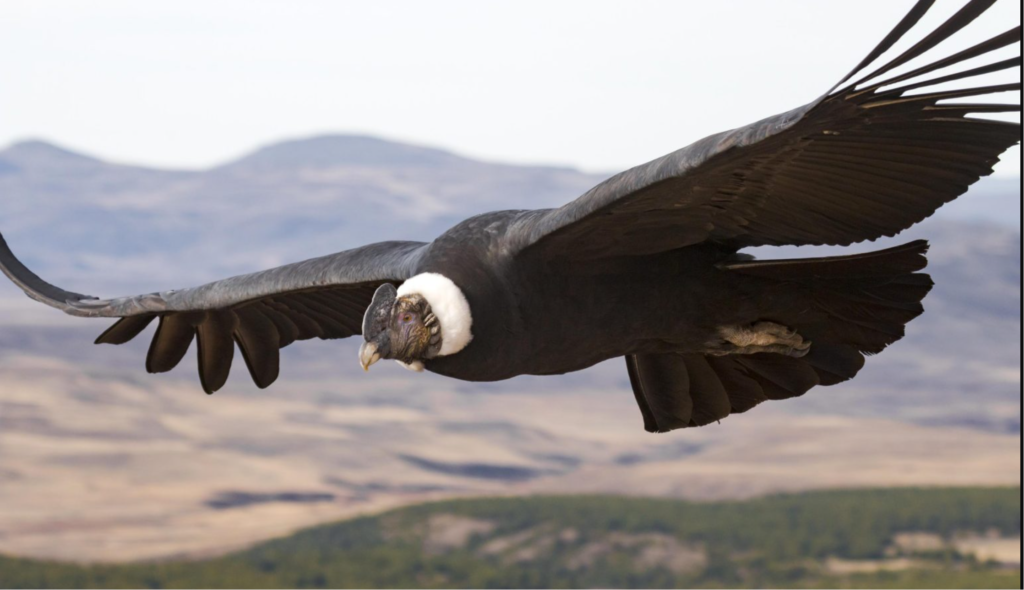Have you ever wondered how some birds can soar in the sky for hours without flapping their wings? What are the secrets behind their magnificent flight performance? A new study by a team of scientists from Swansea University and the University of Chile has revealed some surprising insights into the flight behavior of the world’s heaviest soaring bird, the Andean condor.
The Study of the Andean Condor bird
The Andean condor is a majestic bird that can weigh up to 15 kg and have a wingspan of up to 3.3 m. It lives in the Andes mountains of South America, where it feeds on carrion. To study its flight behavior, the scientists attached high-tech flight-recorders to eight condors and tracked their movements for several months. The flight-recorders logged every wingbeat and twist and turn in flight, as well as the environmental conditions, such as wind and temperature.
Also read : Unlocking The Past: DNA Resurrected From A 6-Million-Year-Old Turtle Shell

The scientists analyzed the data and found that the condors flapped their wings for only 1% of their flight time, and mostly during take-off. The rest of the time, they relied on rising air currents, called thermals, to keep them airborne. One condor managed to soar for more than five hours without flapping, covering a distance of 172 km.
The Implications and Future Prospects
The study revealed that the condors are highly efficient flyers, able to sustain soaring for long periods in a wide range of wind and thermal conditions. The scientists also found that the condors flapped more when they were closer to the ground, where the thermals were weaker and more unpredictable. This suggests that the condors need to find and use thermals wisely, as landing and taking off are costly and risky for such large birds.

The study also has implications for understanding the evolution and ecology of soaring birds, as well as for developing bio-inspired technologies, such as drones and gliders, that can mimic their flight performance. The scientists hope to continue their research and explore how the condors use their sensory and cognitive abilities to navigate the complex and dynamic aerial environment.
Frequently Asked Questions (FAQs)
Q: What is dynamic soaring in birds?
A: Dynamic soaring is a flight strategy observed in soaring birds, where they exploit wind gradients and boundary layers to gain energy for sustained flight. This technique minimizes the need for active wing flapping.
Q: How much time do soaring birds spend flapping their wings?
A: Soaring birds, such as albatrosses and frigatebirds, spend approximately 1% of their flight time actively flapping their wings. The majority of their journey is powered by dynamic soaring and skillful navigation of wind currents.
Q: What is the significance of dynamic soaring for soaring birds?
A: Dynamic soaring is highly significant for soaring birds as it allows them to cover vast distances with minimal energy expenditure. By utilizing wind gradients and atmospheric dynamics, these birds can navigate efficiently during long-distance migrations.
: How do soaring birds harness wind gradients?
A: Soaring birds, particularly those flying over oceans, exploit wind gradients created by the interaction between air and ocean surfaces. Flying close to the water allows them to extract energy from these gradients, contributing to their efficient flight.
Q: What adaptations do soaring birds have for dynamic soaring?
A: Soaring birds have unique adaptations, including long and slender wings and a keen ability to sense air currents. These features, combined with their mastery of dynamic soaring, contribute to their efficient navigation of diverse wind conditions.
Q: Which bird species are known for dynamic soaring?
A: Albatrosses are well-known for their mastery of dynamic soaring, especially during long-distance oceanic migrations. Other soaring birds, such as frigatebirds, also employ dynamic soaring techniques.
Q: How are insights from soaring birds influencing aerodynamics and robotics?
A: Insights from the flight strategies of soaring birds are influencing the study of aerodynamics. Researchers and engineers are drawing inspiration from these natural aviators to enhance our understanding of flight dynamics and apply efficient flight techniques in the development of unmanned aerial vehicles (UAVs) or drones.
Q: What is the environmental impact of human activities on the flight patterns of soaring birds?
A: Human activities, such as climate change and habitat alteration, can impact wind patterns and, consequently, the ability of soaring birds to navigate their habitats. Understanding these environmental impacts is crucial for the conservation of these avian species.
Also read : World AIDS Day: A Time To Unite And Act




































